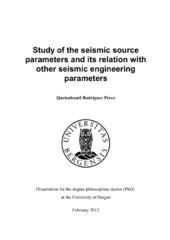| dc.description.abstract | The term seismic source refers to the sources which can generate seismic waves. The seismic source of tectonic earthquakes is represented as a displacement discontinuity on a plane surface as a result of shear faulting. Earthquakes can be defined as a rapid release of strain energy caused by tectonic forces. The elastic wave radiation carries with it information concerning the parameters of faulting or seismic source parameters, so estimating them provides us valuable information about the rupture process. For example, the seismic moment is a measurement of the earthquake size, the radiated energy is a fundamental parameter of the strength of seismic waves generated by an earthquake, and the stress drop provides information about earthquake mechanics. In the present study, two applications of source parameters are conducted. First, the use of earthquake source parameters for estimating scaling laws needed for seismic hazard purposes. Second, the use of seismic source parameters in ground motion simulations. The thesis focuses on two different tectonic regions: the transform fault systems in the Baja California area, and the Mexican subduction zone. In each tectonic area, the earthquakes have different characteristics such as how faults rupture, how waves propagate, attenuate, or disperse through the Earth. In paper 1, a source study and stochastic finite-fault ground simulation is carried out for the 4 April 2010 Mw = 7.2 El Mayor-Cucapah earthquake, a crustal strike-slip event in Baja California. This region is seismically active with strike-slip earthquakes (M ~ 7), but most of them were poorly recorded in the past. The El Mayor-Cucapah earthquake is a wellinstrumented event, allowing the study of the source complexities and site effects at soil and rock site conditions. High amplification was observed on soil stations. Teleseismic waveform inversion shows that the slip distribution consisted of two asperities. Source time function analysis and near-fault ground-motion records show also that the mainshock consists of at least two subevents. This event also illustrates important differences with respect to the subduction zone events, such as long rupture length (~ 140 km), high stress drop, and long source time function. In paper 2, a comparative source parameter analysis between continental and oceanic strike-slip events, and subduction thrust events is carried out. The results support the observation of mechanism dependence of radiated energy and apparent stress reported in previous studies. Most of the scaling relationships commonly used are based on crustal events, and recently some relations for subduction zone based on global datasets have been developed, but those relations not necessary describe the source parameters for the Mexican subduction zone. In paper 2, finite-fault scaling relationships for interplate thrust subduction earthquakes are developed by examining the slip distribution of 15 earthquakes (6.5 < Mw < 8.0) imaged from teleseismic data with an iterative deconvolution method. The obtained models can be used in seismic hazard assessment in Mexico. Asperities have a significant role in the rupture process due to larger slip and stress drop than for the background area. Previous studies show that the asperity areas, as well as entire rupture areas, scale with seismic moment and some relations for source parameters have been developed. Within paper 2, heterogeneous slip models (5 strike-slip; 6.5 < Mw < 7.2, and 15 thrust events) were characterized by determining source parameters on the asperities and on the background area. The results show that the area of the asperities represented about 22 % and 24 % of the total area for strike-slip, and thrust events, respectively. In paper 3, different types of subduction zone earthquakes in the Guerrero seismic gap zone (interplate Mw = 6.6 , thrust near-trench Mw = 6.7, and normal inslab Mw = 6.5 ) are analyzed in terms of source parameters and ground-motion observations. The similarity in magnitude, gives the opportunity to compare the results for the three different types of earthquake and interpret them in terms of the tectonic environments, and seismic hazard. Different methods are used to estimate source parameters in order to observe mainly differences in stress-drop, and radiated energy. The results support the observation that the near trench event has the lowest source parameters (Δσ, ER, and ER/Mo) while the highest values correspond to the normal inslab earthquake. By comparing the radiation efficiency (ηinslab < ηinterplate < ηnear-trench), it is observed that the inslab event has the most efficient rupture mechanics. Source parameter estimates were validated through the stochastic simulations showing that the peak ground acceleration observations can be explained by a stress-drop of 0.38, 3.40, and 34.20 MPa for the neartrench, near-coast, and inslab events, respectively. Ground-motion attenuation relationships are an important tool in seismic risk assessment. In Mexico, most of the effort in this issue has been addressed to develop ground motion models for interplate and inslab earthquakes in central Mexico. No ground-motion attenuation relationships for near-trench events in the Mexican subduction zone and normal inslab events in southern Mexico have been developed. In paper 4, regression models to predict pseudoacceleration response spectra (5% damping), peak ground acceleration, and peak ground velocity for thrust, near-trench events were developed using the one-stage maximum likelihood method. Comparison of the inslab PGA curve of this study and the reported one for central Mexico, suggests that events in southern southern Mexico decay somewhat faster than events in the central region. The results obtained in the thesis can help in better understanding the seismic source and seismic hazard in Mexico. | en_US |
